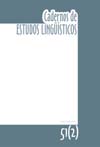Abstract
Comrie (1975) had already noticed that habitual and iterative/frequentative aspects used to be treated as instances of the same aspectual subtype by some papers available in general Linguistics literature. The author distinguishes such instances of the aspectual category by recognizing that habitual aspect expresses the occurrence of an event or state as characteristic of a period of time while iterative expresses the mere repetition of an event or state. Cinque (1999) takes the fact that the iterative aspect is under the scope of the habitual aspect to keep them in different functional projections in the split IP. In our paper, we take the inherently modal nature of habitual aspect (a possibility not available to the iteratives) to show that these instances of aspect must be treated as different manifestations of the aspect category, either on Semantics or on Syntactic grounds. In order to capture the modal nature of the habitual aspect adverbs, we base our analysis on Tescari Neto (2008)’s Tau Condition.
References
BELLERT, I. (1977). On semantic and distributional properties of sentential adverbs. Linguistic Inquiry. 8(2):337–351.
BELLETTI, A. (1990). Generalized Verb Movement: Aspects of Verb Syntax. Torino: Rosenberg & Sellier.
BHAT, D. N. S. (1999). Category of Aspect. In: BHAT, D. N. S. The Prominence of Tense, Aspect and Mood. Amsterdam/Philadelfia: John Benjamins Publishing Company, 43-62.
BHATIIA, A. (2007). Testing Cinque’s hierarchy: Adverb Placement in Hindi. Disponível na página: http://ling.wisc.edu/lso/wpl/6/bhatia.pdf Consulta: 1. outubro.
CASTILHO, A. T. (1993). A predicação adverbial no português falado. Tese (Livre-Docência) FFLCH, Universidade de São Paulo. São Paulo.
CHIERCHIA, G. (1995). Individual-Level Predicates as Inherent Generics. In: CARLSON, G. N.; PELLETIER, F. J. (Eds.) The Generic Book. Chicago: Chicago Univ. Press, 176-223.
CINQUE, G. (1999). Adverbs and Functional Heads: A Cross-Linguistic Perspective. New York, Oxford: Oxford University Press.
CINQUE, G. (2001). Restructuring and the order of aspectual and root modal heads. In G. Cinque e G. Salvi (Eds). Current Studies in Italian Syntax. Amsterdam: Elsevier, 137-155.
CINQUE, G. (2003). The Interaction of Passive, Causative, and Restructuring in Romance. In: TORTORA, C. (ed). The Syntax of Italian Dialects. Oxford: OUP, 50-66.
CINQUE, G. (2005). Deriving Greenberg’s Universal 20 and Its Exceptions. Linguistic Inquiry, n. 36, 315332.
CINQUE, G. (2006). Restructuring” and Functional Structure. In: CINQUE, G. Restructuring and Functional Heads. The Cartography of Syntactic Structures. Vol. 4. New York: Oxford University Press, 1164.
COMRIE, B. (1976). Aspect: An Introduction to the Study of Verbal Aspect and Related Problems. Cambridge: Cambridge University Press.
DALL’AGLIO-HATTNHER, M. M. (1997). A construção do efeito de (des)comprometimento do falante. Estudos Lingüísticos, v. XXVI, 261-269.
ILARI, R.; BASSO, R. M. (2003). Semântica e representações do sentido. Campinas: Departamento de Linguística, IEL/Unicamp.
JACKENDOFF, R. (1972). Semantic interpretation in Generative Grammar. Cambridge: MIT Press.
KAYNE, R. (1998). Overt vs. covert movement. Syntax 1 (2), 128-191.
LEWIS, D. (1975). Adverbs of Quantification. In KEENAN, E. (Ed.) Formal Semantics of Natural Language. Cambridge: Cambridge University Press, 3–15.
NARROG, H. (2005). On defining modality again. Language Sciences, 27/2, 165-192.
RIZZI, L. (2005). Locality and Left Periphery. In: RIZZI, L. (Ed.) The Structure of CP and IP: The Cartography of Syntactic Structures. vol. 2. New York: Oxford University Press.
ROBERTS, I. (2001). Language Change and Learnability. In: BERTOLO, S. (Ed.) Language Acquisition and Learnability. Cambridge: Cambridge University Press, 81-125.
ROBERTS, I. ROUSSOU, A. (2003). Parameters, functional heads and language change. In: ROBERTS, I. Syntactic Change: A Minimalist Approach to Grammaticalization. Cambridge: CUP.
SANTANA, M.S. (2005). A sintaxe do advérbio. (Dissertação – Mestrado em Lingüística). Rio de Janeiro, UFRJ.
TESCARI NETO, A. (2008). AdvPs de aspecto habitual como modalizadores inerentes: um estudo translingüístico. Campinas, UNICAMP. Dissertação (Mestrado em Linguística).
TESCARI NETO, A. (2009). In support (of the universality) of the monoclausality of restructuring contexts. Ms. University of Venice.
The journal CADERNOS DE ESTUDOS LINGUÍSTICOS is granted all the copyright related to the published works. The originals will not be returned. By virtue of being part of this public access journal, the articles are free to use, with their own attributions, in educational and non-commercial applications

